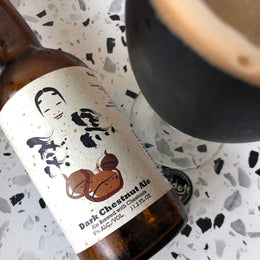The 12 (Most Common) Faults In Beer: We Dive Into The Science Of What Makes Beer Go Wrong

For every dozen of fizzy, crystal clear, creamy foam-headed pint at your local taproom or craft beer shelf, there probably has been one or two that kinda tasted a bit off. Sometimes, no more than an irk at the pangs of your palate, enough to raise an eyebrow, and in hopefully rare instances, a flavour so off putting that makes your face wince.
Like any other fermented beverage, beer is very much a living thing - and as they say; the biggest challenge is not starting out, but consistency. Interview any craft brewer, from the home brewer to maestros overseeing thousand-gallon tanks, and you'll quickly learn that behind every brew are stories of batches tasting off or something going awry.


Established in 2004, Craft Brew Asia is a Singapore-based group that focuses on spreading the knowledge of home brewing. Source: Craft Brew Asia
Of course, as a novice just starting out on home-brewing, having a palate for off-flavours is an indispensable tool in taking your brews to the next level; as head management of a taproom, catching a bad batch before it gets served to a customer could mean a glaringly bad review not being written.
But I argue too as someone often at the other side of the fence, knowing and being able to pinpoint off-flavours in your pint is worth its weight as well. For me at least, apart from the technical know-how to diagnose a bad beer from a good one, knowing the imperfections of a craft only makes me appreciate the amount of hard work and sweat that goes to maintaining a great beer drinking experience, an art that is often too easy to critic.

The fault kit used to spike beers for tasting. Source: Craft Brew Asia
An opportunity came to delve deep into this topic recently. We've attended a class on Off Flavours in Beer, helmed by Dr Joe (aka @beergeekspeaks), who is a longtime community member of Craft Brew Asia. Craft Brew Asia, a non-profit beer enthusiast club based in Singapore, seeks to expand the knowledge of craft beer making to the home brewer and everyday enthusiast.

Dr Joe (@beergeekspeaks on Instagram), whose profession is a senior doctor at NUHS, is also Singapore's first Certified Cicerone. Source: Craft Brew Asia
Seated at Ziggyzaggy, a taproom that features American classic dishes alongside craft beers, we kick off our lesson.
The Methodology
For this masterclass, we're handed two cups of beer each. On the right, the beer serves as a control - unadulterated, straight from the can. On the left, the beer has been spiked with a chemical concentrate meant to represent a fault - either a singular chemical or a mix of a few.

The marked beer indicates the fault, whilst the unmarked beer on the right serves as a control.
We nosed and tasted each fault in one after the other, with the control beer serving as a baseline for our senses. Dr Joe mentioned that whilst there are generally accepted sensory descriptors used for describing beer faults, he emphasised that the descriptors must ultimately make sense to ourselves first and foremost. Dr Joe also advised to analyse each beer fault according to nose, taste and texture, as each person's palate and sense of taste could be more sensitive to specific flavours and aromas.

The list of faults for the day.
With that out of the way, we head into our first fault, one most often encountered by the beginner homebrewer:
1. Acetaldehyde

Industry descriptors: Green apple, cut grass
Whilst most of us know off the top of our head that yeast metabolises sugar to alcohol (or much more specifically, ethanol), the reality of how that works is a lot more complex beneath the surface. An intermediary molecule, called acetaldehyde (CH3CHO) is produced during the multi-step process of yeast turning glucose to ethanol.
![]()
Acetaldehyde. Source: Sigma Aldrich
Acetaldehyde is often characterised as a tart, green apple like aroma and flavour in a beer. Dr Joe highlights that acetaldehyde is a common fault in beers made by homebrewers - as the fermentation process would suggest, a presence in acetaldehyde in beer often means that the yeast has not underwent complete fermentation. This does not mean that professional craft brewers or large commercial breweries don't make this mistake either, as no one's immune to a hastened production schedule!
![]()
Home-brewing kegs. Source: Micet Craft
Luckily, this is an easy fix, and the brew is not doomed - simply letting the beer mature for a longer period of time would ensure that all the acetaldehyde is metabolised.
Common cause: Incomplete fermentation by yeast.
Remedy: Let the beer mature longer.
Most of the attendees concur on the green apple and cut grass notes that acetaldehyde gives. Personally, it reads more like oxidised apple cores or slices of apple that have been left out in the open for too long on the nose, followed by green apple candy, freshly cut grass and watermelon rinds. On the palate, the flavours read similarly to the aromas, giving mostly a grassiness and some old green apple.

2. Acetic Acid

Industry descriptors: Vinegar
Now, this fault is a common one, perhaps one that can be universally picked up by anyone. In its essence, acetic acid smells and tastes like distilled vinegar! In small amounts, acetic acid can be desirable despite its strong nature - especially so in the case of sour beers and lambic beers such as a flanders red, brown ale and Belgian ale, lending more oomph and complexity. However, acetic acid would be largely undesirable if the intended beer profile is not meant to be sour - especially so in the case of lagers and IPAs.

Acetic acid. Source: Wikipedia
Unfortunately, acetic acid is hard to remove from beer - and a homebrewer is likely suffering from a case of contamination from acetic acid producing bacteria. The remedy would be to re-assessing and doing a thorough sanitation of equipment - everything from brewing kegs, utensils to piping.
Common cause: Contamination by acetic acid producing bacteria.
Remedy: Santise all equipment.
Acetic acid to me personally was quite pungent, smelling of distilled vinegar and cleaning agents. On the palate, there is a sour, slightly lactic and sweaty flavour, ending off with a distinctly distilled vinegar flavour.

3. "Contamination"

Industry descriptors: Sour, buttery
Dr Joe explains that with this fault, the underlying cause is a whole host of complex molecules. One of such molecules is 4-methyl-phenol, or 4MP for short (which, upon research, is a molecule often used to train beer brewers on identifying faults). Here, Dr Joe explains that developing an individual sense of the flavour and aroma is key, as this class of aromas read differently to each person.
![]()
4-methyl-phenol. Source: Sigma Aldrich
Farmhouse, barnyard and horse manure are common descriptors for these class of faults, especially for 4MP. Again, for those familiar with farmhouse ales, when controlled, the "brett" flavours and aromas adds a layer of complexity to a beer. However, outside from a narrow range of beers, such a contamination is often an unwanted one.

A pint of farmhouse ale. Source: Wikipedia
Unfortunately, as with the acetic acid fault, the likely cause of farmhouse and barnyard flavours is a case of contamination, particularly those of Brettanomyces yeast. A thorough sanitation of all beer equipment as well as reviewing the sanitation regime would be in order.
Common cause: Contamination by Brettanomyces yeast.
Remedy: Santise all equipment.
For me, this fault reminded me of day-old sweat, rustic barnyard aromas, soured-hay and a poorly ventilated storage room on the nose. On the palate, it tasted like sweat, slightly reminiscent of flor characteristics on fino sherry, but unpleasant.

4. Dimethylsulfide (D.M.S)

Industry descriptors: cooked corn, cooked vegetables
Now, Dimethylsulfide, or D.M.S in shorthand, traces its origin to pilsner malt. The culprit lies in S-methylmethionine (or, SMM for short) - a precursor compound to D.M.S that is produced when barley germinates, found in its embryo.

S-methylmethionine. Source: Wikipedia
Often, much of the SMM is removed when malt is kilned at high temperatures - however, in the case of pilsner malts where malt is lightly roasted, traces of D.M.S may still linger within the barley due to insufficient heating. Fortunately, the fix is easy - boiling the wort (the unfermented liquid when barley is boiled in water to release its sugars) at higher temperatures and for longer often removes the D.M.S before it makes its way into the beer. Some sources also suggest switching to two-row barley malts or substituting a proportion of pilsner malts with other malts.
![]()
Boiling wort. Source: Craft Brewing Equipment
Another possible source of D.M.S in beer lies in yeast. Depending on yeast strain, some yeast contain the necessary enzymes to break down the precursor molecule, dimethyl sulfoxide (or DMSO), that arises from the breakdown of SMM molecules. This in turn introduces D.M.S in to the beer - which could be fixed with optimal brewing temperatures (too high and may increase DMS formation, too low and you may have too much SMM in the beer from insufficient yeast activity).
Dr Joe also points out that more contact time with yeast during fermentation can help break down the D.M.S in beer - though, he warns that yeast autolysis (when the yeast dies) may introduce the D.M.S back into the beer.
Common cause: Pilsner malt, inadequate heat when heating up wort
Remedy: Using other types of malt, boiling the wort for longer and at higher temperatures.
For me, D.M.S on the nose registers moreso of cooked cabbage, overboiled spinach and oxidised apple core, alongside a mild hint of steamed corn kernels. On the palate, it tastes more vegetal, akin to overboiled cabbage or broccoli stems.

5. Diacetyl

Industry descriptors: butter, butterscotch
I'll be the first to admit - this fault was somewhat difficult to pick up on the nose and the palate. In short, this fault is characterised as a butter, cheap movie popcorn and butterscotch on the nose and palate. Whilst a feature in some Bohemian and Czech style beers, and in small doses adds a richer mouthfeel to the brew, diacetly is mostly considered a fault in beer that should be avoided if possible (especially for lighter style beers).
![]()
A microbrewery in Czechia. Souce: Beer Prague
Diacetyl is naturally occurring in beer, being a fermentation byproduct by yeast. When the beer undergoes secondary fermentation (or lagering), diacetyl is often reabsorbed and metabolised by yeast. Hence, the reason for too much diacetyl in beer largely lies on inadequate yeast activity - in particular, when yeast health is not up to par and the yeast did not have enough contact time to metabolise the remaining diacetyl.

Diacetyl. Source: Wikipedia
The fix for excess diacetyl in beer is to use good healthy yeast in the beginning, followed by optimal brewing temperatures and not rushing to bottling or kegging - allowing time for the yeast to undergo secondary fermentation.
Remedy: Use healthy yeast, more contact time with the beer.
Diacetyl for me is much more textural than taste or aroma - on the nose, it registers of buttered sweet popcorn, buttermilk, whey, skim milk and a graham cracker crumble cake base. On the palate, it tastes like skim milk and brown butter, though very slippery and oily on the texture.

6. "Grainy"

Industry descriptors: husk-like, nut-like
Ever had oatmeal and chewed on a piece of oat husk? Imagine that, but permeated through the entire beer - that's the basket of off-flavours "grainy" refers to. More specifically, the "grainy" character refers to an overly nutty, raw grain taste and aroma that is unpleasant, being very astringent and overpowering.

Rice chaffs, the husky part of rice. Source: Wikipedia
As the name implies, the sources of this fault largely lies to the malt - if a malt is too finely crushed, where too much husk is introduced, it could result it too much aldehyde compounds making its way into the beer, giving this characteristic.
Another source of overly grainy flavours could lie in the beermaking, where boiled grains are "oversparged". Sparging, in layman terms, is a way of rinsing spent grain after they have been boiled (to make the wort), extracting out more sugars and flavour. This is a common practice to ensure more yield of beer and reducing wasteage, however, if a homebrewer was too overzealous in the sparging process as Dr Joe pointed out, the resulting extracted liquid could contain too much undesired grain character.
![]()
In some craft breweries, a fly spange is being used to rinse out boiled grains to extract more wort, also known as sparging. Source: Home Brewing
Unfortunately, once it is introduced into the beer, it can't be removed.
Common cause: Overly-milled grain, oversparging
Remedy: Use less milled grain, sparge less after wort boiling.
Nose and taste wise, this fault smells like cardboard, unmilled grain, oat and barley husks to me. On the palate, the taste is bitter, papery and unpleasant, like cardboard tubes, raw peanuts, grain husks and wild seed.

7. Indole

Industry descriptor: Farm, barnyard
This fault, from what I've gathered, isn't very common - but when it does appear in beer, it's disastrous! Whilst the industry descriptors describe Indole as (what I think are euphemisms) farm and barnyard, many craft beer and homebrewing websites point more towards poo, soiled diapers and fecal matter.
![]()
Low alcohol or 0% beers have a higher risk of being contaminated with E. Coli bacteria. Source: NY Post
E. Coli bacteria is the main suspect of causing this fault - which thankfully enough, would not be commonplace in beer as E. Coli bacteria is alcohol sensitive. This means that E. Coli bacteria only really has a chance to multiple and contiminate a beer in its early stages of brewing, where alcohol is still low. Most breweries would not face a problem with E. Coli bacteria if hygiene and sanitation routines are properly enforced - however, it could be an issue with low-ABV or zero-ABV beers.
If this fault is present in your beer, do a thorough sanitation routine of anything that could, would and had touched beer.
Common cause: E.Coli bacteria contamination
Remedy: Thoroughly sanitise all beer equipment and vessels.
(Note that I was battling with a flu prior to this masterclass) To me, my nosing and tasting notes differ from the industry standard - I got UHU glue, stretched PVC plastic, synthetic cleaner and WD-40 on the nose, with the taste registering as plastic, rubber pipes, plastic wrappers and artificial flavouring.

8. Isovaleric Acid
Industry descriptor: Cheesy, old hops, sweaty socks
This beer fault could be smelled from a mile away! As Dr Joe's colleagues were spiking our beer samples prior to the tasting, I could pick up a cheesy, melted cheese fat smell wafting all over the room. The fault is none other than isovaleric acid - one that has as much lovers as haters (surprisingly)!

Isovaleric acid. Source: Wikipedia
Hops, one of the key components of beer, contain alpha-acids, that when boiled in wort, isomerise and form iso-alpha-acids, responsible for the beer's bitter characteristic. Different hops have different components of alpha acids (which we go into detail here covering the four noble hops), each contributing both bitterness and flavour. However, when hops are kept for too long and are not used, these alpha acids oxidise to form isovaleric acid.

Isomers of humolone, an alpha-acid found in hops. Source: Wikipedia
Another way isovaleric acid can be introduced is by Brettanomyces bacteria (shortened to brett), which is commonly used in certain styles of rustic, farmhouse or lambic beers. Remember how I said some folks actually like isovaleric acid? There has been many anecdotes of homebrewers making beers that contained isovaleric acid; which added to the beer's complexity with its slightly cheesy characterisics. This is not unheard of, and in small and sometimes deliberate doses, isovaleric acid adds complexities to beers such as English-style ales or lambic style beers.
![]()
Hops, once opened from their original packaging, has a window of roughly 6 months. Vacuum sealing the bag would help preserve it slightly more. Source: Hazy and Hoppy
Again, all good things come in small doses, and in a clean, simple style beer like lager or pilsner, isovaleric acid is normally considered a fault. An anecdote was shared in the masterclass today, where a homebrewer made a pumpkin ale that had traces of isovaleric acid in it, due to using hops that was slightly past their prime. Whilst a hit amongst his friends, he's unsure if he can ever make the beer again.
Common cause: Using hops that have been stored for too long.
Remedy: Discard old hops, use fresher hops. Review storage conditions of hops.
To me personally, isovaleric acid in a strong dose becomes unpleasant, registering as sweat, old tee-shirts, imitation parmesan cheese and nacho cheese whip that is left for too long on the nose. Taste wise, it registers as old cheese whip, cheese oil, imitation parmesan cheese and artificial cheese flavouring on the palate.

9. "Light Struck"

Industry descriptor: Skunky, toffee, coffee-like
Anyone who's been to college parties, cheap beer gardens, pubs and the like has probably come across this beer fault once in their lifetime (commonly associated with a brand of beer who shall not be named). Storing beer in brown or green tinted bottles as compared to transparent ones didn't arise from a stylistic choice alone, but because of very practical reasons that ensures a better tasting beer.
"Light-struck" is a term that is used to describe a fault that arise from beer being exposed to UV light. Chemically, the same iso-alpha-acids (with isohumulone being the most common) that gives beer its characteristic bitterness and flavour interacts with UV light to form 3-methyl-2-butene-1-thiol shortened to MBT).
![]()
MBT, the culprit of "skunky" beer. Source: Wikipedia
Whilst not everyone has had the misfortune to interact with a skunk, MBT is the same compound skunks use to spray on other animals, and is one unpleasant compound that humans are particularly good and detecting on the nose and palate. Normally attributed to poor storage, a beer can get light-struck at anytime of the brewing process, from the introduction of hops into beer, fermentation, and even up to bottling.
![]()
Leaving out your beer in the sun - a big no-no! Source: Popsci
Hence, green and brown tinted bottles are used to store beer - they filter out some light from reaching the beer and help preserve the iso-alpha-acids from turning into skunk-juice. That said, green and brown bottles alone doesn't stop this from happening completely (with brown bottles stopping more light and UV light from entering the beer than green bottles). When receiving beer, do not leave beer exposed to the sunlight for too long, and keep beer shelves away from windows.
![]()
Source: Maxim
Worst, a lime wedge in the neck of the beer bottle is a band-aid to ward off some of those skunky flavours and aromas.
*Fun fact: Dr Carl Lintner, who established a brewing academy in Freising, Germany in 1865, found out in 1875 that beer exposed to sunlight produced off flavours. Close to a century later in 1961, it was scientist

10. "Metallic"

Industry descriptor: Metal, tin-like, blood
This, by most accounts, would be a rare fault to pick up in beer. However, home brewers and craft brewers should take exceptional notice if this fault is present in beer.
![]()
Rust in beer equipment. Source: Craft Brewery Equipment
Dr Joe mentions that metallic tastes in beer most likely indicate rusting equipment - be it the brewing vessel, boiling vessels or pipes. Rust or iron containing compounds make their way into beer as a result - hence looking for chips in beer equipment, exposed iron or rust is key to eliminating the problem. Using the wrong cleaning agents could also cause ions of iron or copper to leech into the brew - hence, making sure that the right cleaning agent is being used is paramount too. Prevention is better than cure - and homebrewers or small breweries would be better off using high quality stainless steel to begin with.
In rarer cases, a high iron or copper content in the water used may lead to metallic tastes in beer as well - which then, a water analysis should be conducted to diagnose the problem.
Common cause: Chips or rust in brewing equipment.
Remedy: Change brewing equipment, use high quality stainless steel.
On the nose, this fault read like steel cut oats, coins, and slightly sulfuric, with the palate registering iron fillings, steel, and raw steel cut oats.

11. "Papery"

Industry descriptor: Cardboard, oxidised
Some sources call this a "papery", cardboard flavour. Others say the smell and taste resemble stone fruits. Both point towards the molecule trans-2-nonenal - a result of oxidation due to (often times) improper storage, especially so when the beer is stored at warm places.
![]()
The quick summary of beer storage: Cold, dark, upright. Source: Columbia Distributing
No matter the format of beer, bottle or canned, it is impossible to eliminate oxygen and oxidation completely. Hence, proper storage to keep the beer "fresh" is always recommended to prolong its shelf life - such as keeping the beer in a refrigerated, dark place. Unfortunately, beer, especially pale lager beer, can't be kept for too long, as time and oxidation will slowly but surely happen. Unfortunately, once the beers are oxidised, the faults can't be removed from the beer. So, for those beers that are sitting on the shelf... down the gullet!
Common cause: Improper and warm storage
Remedy: Dark and cold storage.
On the nose for me, the fault smells of paper cups, cardboard boxes, office paper, and dusty office shelves. On the palate, the fault tastes of paper cups, cardboard and dusty shelves.

12. H2S (Hydrogen Sulfide)

Industry descriptor: Sulphidic, rotten eggs
H2S: the smell of rotten eggs that is awfully repungent. The human senses are tuned to be extremely sensitive to this molecule, being able to pick it up in parts per billion! Whilst a very minimal amount of H2S could be desired in some beer styles, for the majority of beers, H2S should be avoided as best as possible.
Source: Brewing Science
Most sources point to the yeast strain and the conditions of fermentation to be the biggest factor of H2S production in beer. When brewing lager, H2S gas is normally produced and to be expected, where yeast cells metabolise sulphur containing molecules and compounds in the wort (from roasting the malt) or from hops. Most H2S is produced when the yeast cells are undergoing the highest metabolism, but with the production of CO2, greatly reduced the H2S towards the end of fermentation. Finally, when the fermentation is complete in a low oxygen environment, the yeast cells stop metabolising and start reabsorbing some of the H2S produced in beer.
As such, much of the faults lie in poor nutrition, unoptimal fermentation temperatures as well as inadequate aging time on yeast. This is especially so for lager yeast, which requires low temperatures and a long fermentation time.
Common cause: Inadequate fermentation conditions
Remedy: Using a different strain of yeast or matching optimal conditions for fermentation.
For me, this last fault smelt like hard boiled eggs, spoiled eggs and egg shells, with the taste reminiscent of boiled egg yolk.

Final Thoughts
Of course, there is much more that goes into each beer fault, with those listed here a simplification. Beer faults don't necessary originate on the brewer, but could lie in adequate storage and contamination that happens during beer service at a taproom. I truly think that getting at the very least acquainted to beer faults, from the home brewer, to server or just a fan, sheds light on just how much effort and know-how it takes to deliver a good batch of beer.

Source: Craft Brew Asia
To that, cheers to the many in-perfect and perfect brews to come!

@vernoncelli
P.S To those needing a cozy, laid back beer taproom with unmistakably U.S Southern food fair, make Ziggy Zaggy a place to guzzle a pint. Whilst I cannot vouch for the authenticity of creole American dishes having not been to the place itself (and not from there), I was nevertheless shocked to see gumbo in the food menu. And for the drizzling cold day that it was, the gumbo was the perfect warm dish that did wonders to my flu that day. Definitely give it a try!

Gumbo, picture from @ziggyzaggysg.






